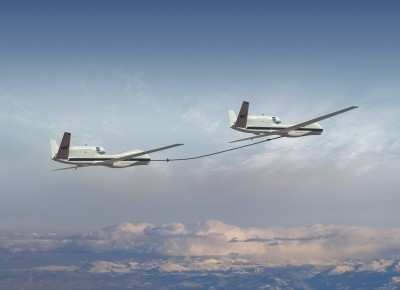Sun, Jul 04, 2010
Will Be The World's First Such Operation Between Two UAVs
DARPA has awarded a $33 million contract to Northrop Grumman
Corporation to demonstrate aerial refueling of a NASA Global Hawk
unmanned aerial vehicle (UAV) by a sister ship. The program will be
designated KQ-X. Northrop Grumman will retrofit two of the high
altitude long endurance (HALE) UAVs, one aircraft pumping fuel into
the other in flight through a hose-and-drogue refueling system. The
aerial refueling engagement will be completely autonomous.

Artist's Illustration
"Demonstrating the refueling of one UAV by another is a historic
milestone," said Carl Johnson, vice president, Advanced Concepts
for Northrop Grumman Aerospace Systems. "It adds aerial refueling
to the list of capabilities that can be accomplished autonomously
by Global Hawks; it opens the door to greatly expanded operational
utility for UAVs; and, as a side benefit, it promises to increase
the safety and reliability of aerial refueling between manned
aircraft by reducing pilot workload."
There are several revolutionary aspects to the KQ-X program. Not
only will the aerial refueling be autonomous, but since Global
Hawks are HALE UAVs, it will also take place at a much higher
altitude than has been previously demonstrated with manned
aircraft. It will also be the first time that HALE UAVs have flown
in formation. "The importance of aerial refueling is clear in the
way military aviation depends on it today," said Jim McCormick, the
DARPA program manager for KQ-X. "This demonstration will go a long
way towards making those same advantages a reality for the next
generation of unmanned aircraft."

Engineering work will be accomplished at the Northrop Grumman
Unmanned Systems Development Center in Rancho Bernardo, California.
Pilots from NASA, NOAA, and Northrop Grumman will fly the Global
Hawks from the NASA Dryden Flight Research Center at Edwards Air
Force Base, also in California. Sargent Fletcher, Inc. and Sierra
Nevada Corporation are major KQ-X subcontractors.
More News
Aero Linx: Model Aeronautical Association of Australia MAAA clubs are about fun flying, camaraderie and community. For over 75 years, the MAAA has been Australia’s largest fl>[...]
Touchdown Zone Lighting Two rows of transverse light bars located symmetrically about the runway centerline normally at 100 foot intervals. The basic system extends 3,000 feet alon>[...]
“Discovery and innovation are central to our mission at Virgin Galactic. We’re excited to build on our successful record of facilitating scientific experiments in subor>[...]
How To Get A Story On Aero-TV News/Feature Programming How do I submit a story idea or lead to Aero-TV? If you would like to submit a story idea or lead, please contact Jim Campbel>[...]
Student Pilot Reported That During Rotation, “All Of A Sudden The Back Of The Plane Kicked To The Right..." Analysis: The student pilot reported that during rotation, “>[...]
 ANN's Daily Aero-Linx (05.02.24)
ANN's Daily Aero-Linx (05.02.24) ANN's Daily Aero-Term (05.02.24): Touchdown Zone Lighting
ANN's Daily Aero-Term (05.02.24): Touchdown Zone Lighting Aero-News: Quote of the Day (05.02.24)
Aero-News: Quote of the Day (05.02.24) ANN FAQ: Contributing To Aero-TV
ANN FAQ: Contributing To Aero-TV NTSB Final Report: Cirrus Design Corp SR20
NTSB Final Report: Cirrus Design Corp SR20




